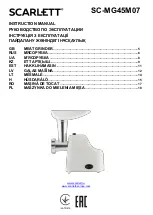
3 4
G B
Other special safety instructions
for cutting grinding
a) Avoid blocking the cutting disc or pres-
sing down too hard. Do not make any
excessively deep cuts. Overloading the
cutting disc increases wear and its ten-
dency to tilt or block and, with that, to
kickback or break the grinder.
b) Avoid the area in front of and behind
the rotating cutting disc. When you
move the cutting disc by itself in the
workpiece, in the event that the electric
tool kicks back with the rotating disc, it
can spin directly towards you.
c) If the cutting disc jams, or you interrupt
your work, switch the device off and
hold it until the disc has come to a full
stop. Never try to pull the cutting disc
out of the cut while it is still running,
because it can kick back. Identify and
correct the cause of the jamming.
d) Do not switch the electric tool on again
as long as it is in the workpiece. Allow
the cutting disc to first reach its full
rotational speed before you carefully
resume with the cutting. Otherwise, the
disc may catch, spring away from the
workpiece or cause a kickback.
e) Support plates or workpieces to reduce
the risk of kickback from a jammed cut-
ting disc. Large workpieces may bend
under their own weight. The workpiece
must be supported on both sides of the
disc, near the cutting disc as well as
also at the edge.
f) Be particularly careful for pocket cuts in
existing walls or other areas where you
cannot see what is there. The cutting
disc may cause a kickback when it cuts
into gas or water lines, electrical lines
or other hidden objects.
Additional safety instructions
for sanding
Special safety instructions for
sanding:
•
Do not use overly large sand-
paper sheets; follow the
manufacturer‘s information for
sandpaper sizes.
Sandpaper sheets
which extend beyond the sanding plate
can cause injuries and can block, tear
the sandpaper, or cause kickback.
Additional safety instructions
for polishing
Special safety instructions for
polishing:
•
Let no loose parts of the poli-
shing bonnet, particularly at-
tachment strings. If you shorten
the fastening cords verse defrost
oder.
Loose, revolving attachment
strings can capture your fingers or be
-
come entangled in the workpiece.
Additional safety instructions
for working with wire brushes
Special safety instructions for
working with wire brushes:
•
Be aware that the wire brushes
also lose wire pieces during typi-
cal use. Do not overload the wi-
res by pressing down too hard.
Flying wire pieces can very easily penet-
rate thin clothing and/or your skin.
•
If a protective hood is recom-
mended, do not allow the wire
brushes and the protective hood
to touch each other.
The diameter













































